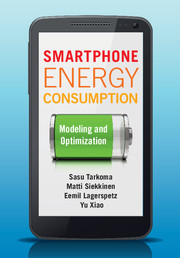Book contents
- Frontmatter
- Contents
- Preface
- List of abbreviations
- Part I Understanding energy consumption
- Part II Energy management and conservation
- Part III Advanced energy optimization
- 11 Overview
- 12 Traffic scheduling
- 13 Exploiting multiple wireless network interfaces
- 14 Mobile cloud offloading
- 15 Example scenarios for energy optimization
- 16 Future trends
- Appendix A An energy profile application
- Index
- References
16 - Future trends
from Part III - Advanced energy optimization
Published online by Cambridge University Press: 05 August 2014
- Frontmatter
- Contents
- Preface
- List of abbreviations
- Part I Understanding energy consumption
- Part II Energy management and conservation
- Part III Advanced energy optimization
- 11 Overview
- 12 Traffic scheduling
- 13 Exploiting multiple wireless network interfaces
- 14 Mobile cloud offloading
- 15 Example scenarios for energy optimization
- 16 Future trends
- Appendix A An energy profile application
- Index
- References
Summary
Smartphones have evolved in leaps and bounds during the last decade and this evolution is continuing with new software and hardware capabilities as well as new application domains, such as augmented reality and the Internet of Things (IoT). In this chapter we briefly examine future smartphone trends from the perspective of energy consumption. We conclude that radical disruptions are not likely in the near future, keeping energy a first-class resource for mobile devices and warranting new solutions to maintain and improve device battery life.
Future smartphone
The smartphone has become the essential instrument for our daily lives, supporting a plethora of usage scenarios from the workplace to the home and leisure. Today's smartphone is a small-factor, high-performance computer that can offer graphics resolution and power on a par with the previous generation of game consoles. The communications capabilities of smartphones have evolved tremendously over the past decade and now high-speed, low-latency 4G and beyond networks, Wi-Fi, and local area networks are ubiquitously supported. The sensing capabilities have improved dramatically with GPS, acceleration, light, and temperature to give some examples of onboard sensors and the sensing capabilities include complex gestures and voice.
In addition to the hardware capabilities, the mobile-application ecosystem has had stellar success in recent years since iOS, Android, and Windows Phone were launched. Application developers have used the mobile platform APIs and the hardware capabilities of smartphones to create new innovative applications that in many cases combine sensors and communications capabilities in unexpected ways.
- Type
- Chapter
- Information
- Smartphone Energy ConsumptionModeling and Optimization, pp. 315 - 323Publisher: Cambridge University PressPrint publication year: 2014



